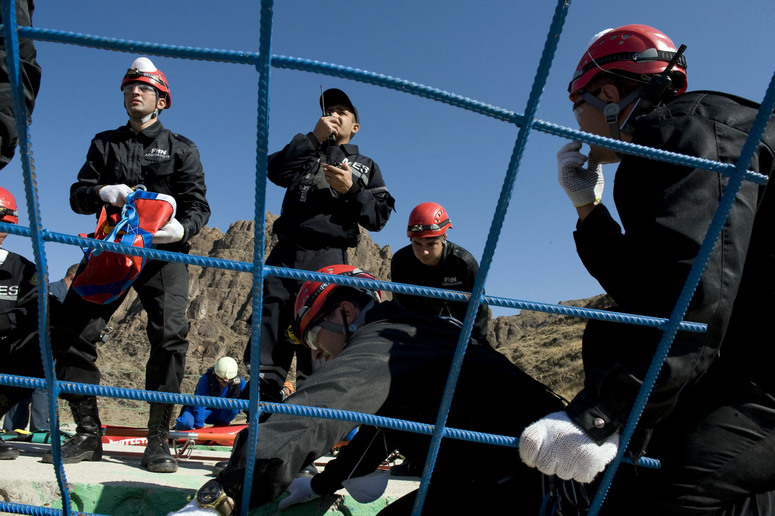Euro-Atlantic Disaster Response Coordination Centre
The Euro-Atlantic Disaster Response Coordination Centre (EADRCC) is NATO’s principal civil emergency response mechanism in the Euro-Atlantic area. It is active all year round, operational on a 24/7 basis, and involves all NATO Allies and partner countries. The Centre functions as a clearing-house system for coordinating both requests for and offers of assistance mainly in case of natural and man-made disasters.

- The EADRCC plays a facilitating role in coordinating offers of support and requests for assistance between NATO member and partner countries. In the case of a disaster requiring international assistance, it is up to individual NATO Allies and partners to decide whether to provide assistance, based on information received from the EADRCC.
- In addition to natural and man-made disasters, the Centre is also available to coordinate international assistance during crises and Article 5 collective defence situations.
- The EADRCC’s tasks are carried out in close cooperation with the United Nations Office for the Coordination of Humanitarian Affairs (UN OCHA), which retains the primary role in the coordination of international disaster relief operations.
- In response to the COVID-19 pandemic, the EADRCC is coordinating requests for and offers of international assistance from NATO Allies and partner countries.
- As part of the NATO International Staff Operations Division, the EADRCC assisted with the evacuation of NATO-affiliated Afghans and their families from Afghanistan in August 2021, with team members playing significant roles in Kabul, Qatar and at Allied Air Command in Ramstein, Germany.
-
Support for national authorities in civil emergencies
In case of civil emergencies, the EADRCC is NATO’s principal response mechanism, working primarily in the Euro-Atlantic area. The Centre forwards requests for assistance to NATO and partner countries, which in turn respond by communicating their offers of assistance to the EADRCC and/or the affected country. It tracks the assistance offered through other international mechanisms or bilaterally from states, assistance accepted by the stricken country, delivery dates and assistance still required, as well as the situation on the ground. This information is circulated to NATO and partner countries in the form of situation reports, and is also published on the EADRCC website.
Since March 2020, the EADRCC has coordinated requests for and offers of international assistance from NATO Allies and partner countries in response to the COVID-19 pandemic. The EADRCC has helped facilitate the transfer of medical supplies such as masks, gloves, disinfectant and ventilators to countries that have requested assistance.
All of the EADRCC’s tasks are performed in close cooperation with the United Nations Office for the Coordination of Humanitarian Affairs (UN OCHA), which retains the primary role in the coordination of international disaster relief operations. The Centre is designed as a regional coordination mechanism, supporting and complementing UN and European Union (EU) efforts.
-
Multinational team of experts
The Centre is located at NATO Headquarters in Brussels, Belgium. It is staffed by a small team composed of members of NATO’s International Staff and voluntary national contributions from NATO and partner countries. The Centre liaises closely with UN OCHA, NATO Military Authorities and other relevant international organisations such as the EU’s Emergency Response Coordination Centre. When a disaster occurs, for example during the COVID-19 pandemic, the EADRCC can temporarily be augmented with additional personnel from NATO and partner delegations to NATO, or NATO’s international civilian and military staff. In addition, the EADRCC has access to national civil experts that can be called upon to provide the Centre with advice in specific areas in the event of a major disaster.
-
Other activities
In addition to its role as NATO’s principal disaster response mechanism, the EADRCC conducts regular capacity-building and training events in Allied and partner countries to enhance national resilience through improved disaster preparedness.
In 2021, the training activity is taking place in Ohrid, in the Republic of North Macedonia.
-
Historical background
Based on a Russian proposal, the EADRCC was established in 1998 by the Euro-Atlantic Partnership Council (EAPC) as a partnership tool of NATO’s civil emergency planning and as one of the basic elements of the EAPC policy on cooperation in the field of international disaster relief.
Initially, the EADRCC was involved in coordinating humanitarian assistance efforts from EAPC countries that supported refugees during the Kosovo War in the late 1990s. Since then, however, the Centre has responded to many requests for assistance received mainly from states stricken by natural disasters such as forest fires, floods, earthquakes and hurricanes.
In January 2004, the North Atlantic Council, NATO's principal political decision-making body, widened the EADRCC’s mandate to include responding to assistance requests from the Afghan government in the case of natural disasters. Three years later, that mandate was extended to all areas where NATO is involved militarily. In 2009, the countries of the Mediterranean Dialogue (MD) and those of the Istanbul Cooperation Initiative (ICI) were given direct access to the Centre, followed by other partners across the globe in December 2011.
